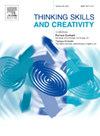小学数学课堂中的不插电活动:对学生计算思维和数学创造力的影响
IF 3.7
2区 教育学
Q1 Social Sciences
引用次数: 0
摘要
人工智能技术的飞速发展带动了计算思维(CT)教育的普及。然而,尽管有些研究探讨了编程对认知的益处,但有关不插电活动对小学数学课堂影响的研究却十分有限。本研究针对三年级学生开展了为期十周的准实验研究,对研究结果进行了定性和定量分析。研究设计了一系列不插电的活动,包括数学游戏、动手制作数学逻辑板和计算购物折扣。总体目标是研究这些不插电活动对学生数学创造力和 CT 的影响。参加基于不插电活动的数学课程的学生(47 人)与参加传统讲授式数学课程的学生(46 人)进行了比较。结果表明,不插电活动在培养学生的CT和数学创造力方面具有显著优势,包括三个维度,即提出问题的创造力(t = 5.830,p < 0.01)、解决问题的创造力(t = 6.633,p < 0.01)和创造力自我效能感(t = 7.554,p < 0.01)。此外,研究还揭示了学生的数学创造力与 CT 之间的预测关系。定量分析的结果得到了教师和学生访谈数据的支持,学生们对不插电活动感到兴奋和感兴趣,而一些使用讲授法的学生则表示感到无聊和缺乏互动性。这项研究为数学和计算机辅助教学实践提供了宝贵的见解,强调了不插电活动是一种创新的教学方法,为传统的数学教学带来了新的可能性,有望应用于 K-12 课程。本文章由计算机程序翻译,如有差异,请以英文原文为准。
Unplugged activities in the elementary school mathematics classroom: The effects on students’ computational thinking and mathematical creativity
The rapid development of artificial intelligence technology has led to the proliferation of computational thinking (CT) education. However, research on unplugged activities’ influence in elementary math classrooms is limited, despite some exploring programming's cognitive benefits. This study presents both qualitative and quantitative analyzes stemming from a ten-week quasi-experimental research endeavor, specifically tailored for third-grade students. The research devised a series of unplugged activities, encompassing mathematical games, hands-on construction of mathematical logic boards, and calculating shopping discounts. The overarching objective was to investigate the impact of these unplugged activities on students’ mathematical creativity and CT. Students participating in a mathematics curriculum based on unplugged activities (N = 47) were compared with students participating in a traditional lecture-based mathematics curriculum (N = 46). The results indicated that unplugged activities exhibited significant advantages in fostering students’ CT and mathematical creativity across three dimensions, namely, problem-posing creativity (t = 5.830, p < 0.01), problem-solving creativity (t = 6.633, p < 0.01), and creative self-efficacy (t = 7.554, p < 0.01). Furthermore, the study revealed a relationship between students’ mathematical creativity as a predictor of CT. The results of the quantitative analysis were supported by the teacher's and students’ interview data, and the students felt excited and interested in the unplugged activities, whereas some students using the lecture-based method reported boredom and lack of interactivity. This research offered valuable insights for mathematics and CT education practice, underscoring unplugged activity as an innovative instructional approach that brings forth new possibilities for traditional mathematics teaching, with potential applications in the K-12 curriculum.
求助全文
通过发布文献求助,成功后即可免费获取论文全文。
去求助
来源期刊

Thinking Skills and Creativity
EDUCATION & EDUCATIONAL RESEARCH-
CiteScore
6.40
自引率
16.20%
发文量
172
审稿时长
76 days
期刊介绍:
Thinking Skills and Creativity is a new journal providing a peer-reviewed forum for communication and debate for the community of researchers interested in teaching for thinking and creativity. Papers may represent a variety of theoretical perspectives and methodological approaches and may relate to any age level in a diversity of settings: formal and informal, education and work-based.
 求助内容:
求助内容: 应助结果提醒方式:
应助结果提醒方式:


